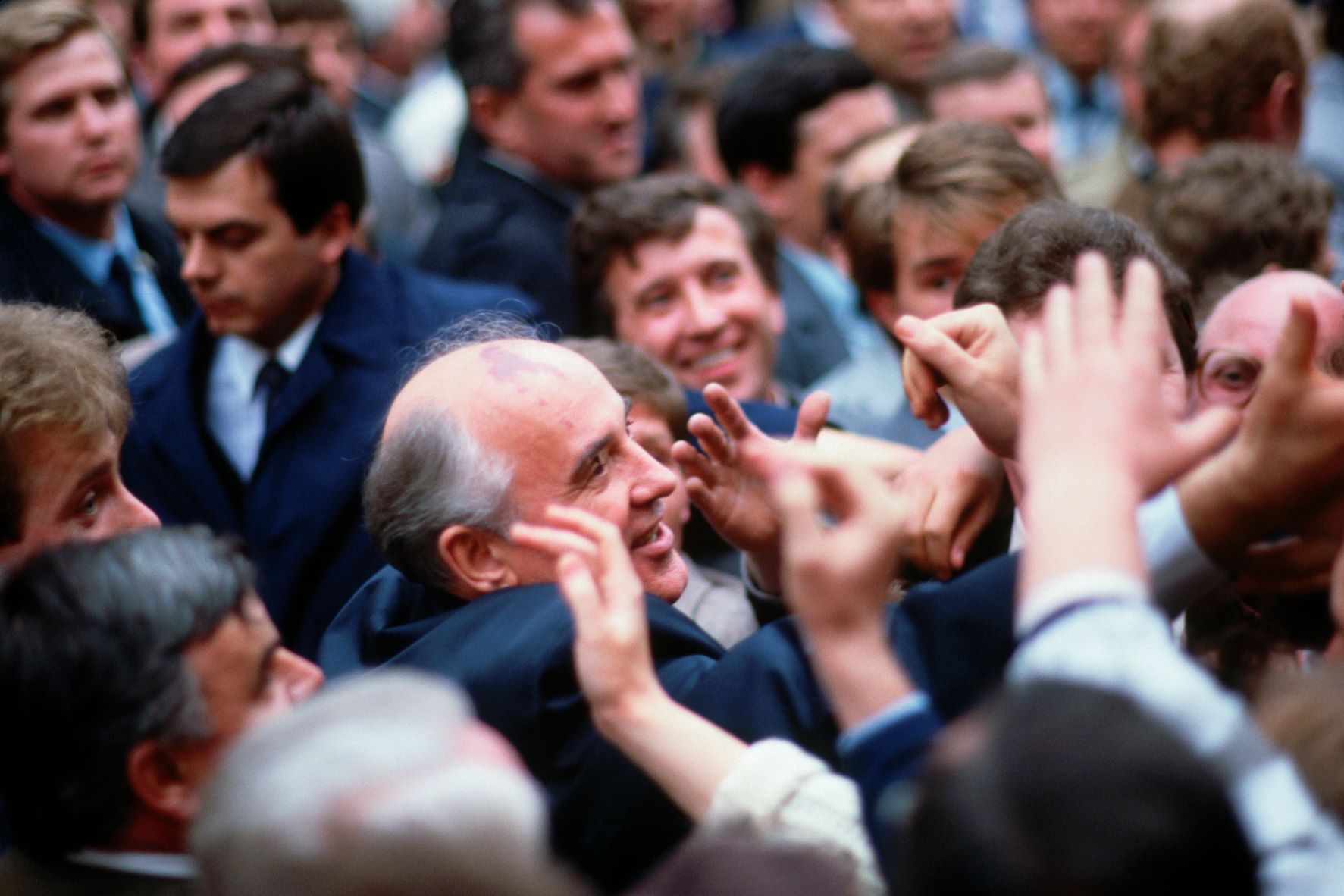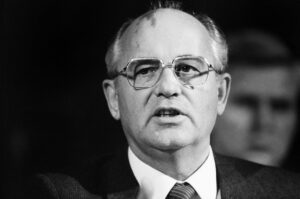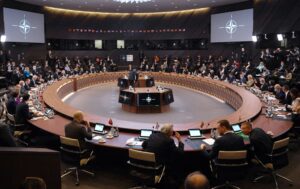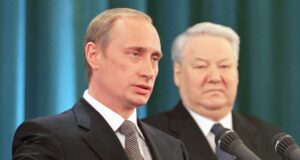
The last Soviet leader brought down his regime and ended the Cold War. The free world owes him a debt of gratitude.
September 2022
With Russia invading Ukraine and populists undermining democracy in the West, the world is a far cry from what Mikhail Gorbachev (1931–2022) and many others envisioned after the collapse of communism. Nevertheless, Gorbachev’s six short years in office had a profound impact on global freedom that can still be felt today.
To understand Gorbachev’s influence, it helps to recall what the world was like before he came to power. In 1985, when Gorbachev became general secretary of the Communist Party of the Soviet Union (CPSU), just a quarter of the world’s countries were democracies. While the “third wave” of democratization had led to transitions in Southern Europe and Latin America, democracy had little presence outside Western Europe and North America. De jure single-party regimes dominated Africa, and political pluralism was totally absent in Eastern Europe and the USSR. With the exceptions of India and Japan, democracy did not exist in Asia, where even highly developed countries such as South Korea and Taiwan were authoritarian.
During the Cold War, the Soviet Union was an important source of authoritarian vitality. From the 1960s until the 1980s, it provided a model for single-party dictatorships that was adopted throughout the developing world. Furthermore, the Soviet Union’s “revolutionary imperial paradigm,” characterized by control over weaker states in Eastern Europe and support for pro-Soviet movements and governments in the developing world, bolstered authoritarian rule across the globe. The USSR gave significant support to autocracies in Europe, Latin America, Africa, and Asia, helping to foster intense geopolitical rivalry and ideological polarization that legitimized numerous U.S.-backed right-wing dictatorships.
Before Gorbachev took the reins of power, the Soviet Union itself had been marked by a deadening stability in which all aspects of life were under tight Communist Party control. Opposition consisted of a few isolated dissident groups that never presented any kind of threat to state power. All forms of protest were quashed: In the thirty or so years before Gorbachev’s rise, the Soviet Union had seen only 45 nonstate mass actions (including riots at sporting events) with more than a thousand participants. Any independent initiative — even pro-Soviet — was quickly crushed. Thus in 1978, when thirteen-year-old Marina Morozova gathered three of her friends in front of the American embassy in Moscow to protest U.S. plans for a neutron bomb, the KGB surrounded the girls and took them in for questioning. Such spontaneous activities, it was feared, could eventually turn against the regime if left unchecked.
After coming to power in 1985, Gorbachev opened up the Soviet Union and dramatically improved the prospects for pluralism and democracy in the world. Believing that increased popular engagement in public life would help to revitalize the Soviet system, Gorbachev relaxed totalitarian controls over society. In late 1986, he released the dissident Andrei Sakharov from exile and eased censorship rules, generating a wave of discussion about previously forbidden topics such as Stalin’s Great Terror of 1936–38 and the 1939 Molotov-Ribbentrop Pact between the USSR and Nazi Germany. But the resulting explosion of open discussion occurred just as failed economic reforms were contributing to increased shortages of basic consumer goods. Thus, instead of revitalizing communism, Gorbachev’s liberal reforms triggered discontent and protest.
Then in the summer of 1988, Gorbachev used his powers as general secretary to fatally weaken the very foundation of his own power, the Communist Party. Following an open attack on his reforms in a major Soviet newspaper (the “Nina Andreyeva letter”), Gorbachev convened the historic 19th All-Union Party Conference of the CPSU, where delegates were forced to sharply reduce the party apparatus and eliminate key mechanisms of control over economic enterprises.
Most momentously, the party conference opened the CPSU to direct competition from outsiders with the creation of a new bicameral legislature. A USSR Congress of People’s Deputies, consisting of 2,250 delegates, would be chosen through semi-competitive elections. At the same time, Gorbachev used his position as head of the party to discourage efforts by the apparatus to defend itself. According to Archie Brown’s 1996 account, Gorbachev told an aide that “seventy percent of the apparatus of the Central Committee and of the Central Committee itself are against me and hate me . . . You mustn’t let go of the reins of a mangy, mad dog!” Communist functionaries waited in vain for directives from Moscow. Confusion reigned.
In a special election to the Congress in March 1989, numerous highly placed functionaries lost, while key proponents of reform, including Sakharov, won overwhelmingly. Gorbachev’s archenemy, Boris Yeltsin — then a disgraced former Politburo member — garnered 89 percent of the vote in Moscow. Then in 1990, the Soviet Union’s fifteen Republics each held elections that brought to power anti-Soviet leaders in several republics, including Yeltsin, who became president of Russia in 1991.
Change Was in the Air
This period is remembered by most Russians as a one of severe shortages and uncertainty. But for many activists, intellectuals, and at least one twenty-year-old American college student in Moscow, it was, for a fleeting but magical moment, a near-utopia. On the one hand, enough communism remained that it was possible to keep a job and get by while rarely showing up for work. A good friend of mine, for example, had a job at a hospital, but spent most days reading and translating English-language detective novels. On the other hand, with the party-state held in check, numerous discussion clubs, called neformaly (informals), sprouted up across the Soviet Union, promoting everything from ultranationalism to social democracy to regional independence. With the Communist Party in retreat, the possibilities for the future seemed limitless. Utopian visions such as anarchism suddenly felt plausible.
As a Russian-language student in Moscow in 1989, who understood about half of what was said to me, I desperately tried to drink it all in. Abusing my access as a U.S. citizen to a photocopier in the American embassy, I duplicated informal journals filled with discussions about Latin American socialism, the 1968 Soviet invasion of Czechoslovakia, and Stalinism. (Ignoring a sign on the machine indicating a limit of fifty pages, I xeroxed hundreds.)
This was enough to buy me access to a number of intellectual and activist networks. I became a member of the informal group Democratic Perestroika when its leader, Oleg Rumyantsev, decided he wanted the group to be international. On the invitation of Andrei Isaev, an enterprising Soviet student, I attended a meeting of the Confederation of Anarcho-Syndicalists, held in the basement of a Komsomol (Communist youth organization) building, to translate for a group of Swedish activists.
Yet these manifestations of openness were quite fragile, surviving only as long as authoritarian leaders and structures remained weak and disoriented. While Russian authoritarian rule was hardly inevitable, in the absence of any powerful, mass-based organization or extensive foreign pressure, the forces of democracy were vulnerable to attack. In 1993, President Yeltsin dissolved the Russian legislature and imposed a system of superpresidentialism. In 1999, he was succeeded by Vladimir Putin, who would go on to destroy Russia’s nascent pluralism. My own networks witnessed a similar evolution. The anarchist Andrei Isaev became a top Putin official and mouthpiece for the regime, and several close friends from the Gorbachev era are now ardent defenders of Russia’s invasion of Ukraine.
While Gorbachev’s reforms failed to create a free society in Russia, they have had a lasting impact on global freedom. The Soviet collapse gave rise to new autocracies in Russia and Central Asia, but it also enabled democratization in Armenia, the Baltic states, Moldova, and Ukraine. Gorbachev’s decision to abandon the revolutionary imperial paradigm catalyzed regime transitions across the globe. Ending support for Communist governments in Eastern Europe directly facilitated the collapse of communism there. In Eastern Europe today, two-thirds of countries are fully democratic, and no regimes are entirely authoritarian.
More broadly, the easing of Cold War tensions directly contributed to democratization in Chile, El Salvador, Guatemala, Nicaragua, Panama, Paraguay, South Africa, Taiwan, and arguably South Korea, among others. For the first time in world history, no legitimate alternative model exists to challenge electoral democracy. (Contemporary populist politicians certainly have undermined democracy, but they have almost never attacked competitive elections as such.) There are now more competitive democratic countries than at almost any time in world history — nearly twice as many as in 1985. About twenty years after commentators first expressed concerns about democratic backsliding, roughly half the countries in the world are democratic or nearly so according to the Varieties of Democracy (V-Dem) project’s index — down just a bit from a historical high of 54 percent in 2017, and significantly better than in 1985. The number of closed autocracies remains far lower than in the not-too-distant past, roughly three times fewer than in the early 1970s.
The nature of authoritarianism also has fundamentally changed since the end of the Cold War. Certainly “old fashioned” dictatorships without elections, such as China and Saudi Arabia, are still around. But there are now many competitive authoritarian regimes where elections remain the primary means of gaining and keeping power. Indeed, the commonly accepted dividing line between democracy and autocracy has shifted significantly since the Cold War ended: Cold War–era Japan, whose ruling Liberal Democratic Party used tight control over fiscal transfers to stay in power for three decades, was considered a democracy at the time but would not be today; whereas Viktor Orbán’s Hungary almost certainly would have been deemed democratic before 1989. These changes can be directly traced to Gorbachev’s efforts to end the Cold War. Democracy today obviously confronts significant threats. Yet more than thirty years after Gorbachev left power, his legacy continues to bolster pluralism in the world today.![]()
Lucan Ahmad Way is professor of political science at the University of Toronto. He is coauthor (with Steven Levitsky) of Revolution and Dictatorship: The Violent Origins of Authoritarian Durability (2022).
Copyright © 2022 National Endowment for Democracy
Image Credit: Peter Turnley/Corbis/VCG via Getty Images
| FURTHER READING | ||

The Man Who Dared to Change the WorldMikhail Gorbachev risked everything. Neither Russia nor the West could live up to his vision. |

The Rebirth of the Liberal World Order?Vladimir Putin’s invasion of Ukraine has done something for the world’s democrats they could seemingly not do for themselves—given them a renewed unity, purpose, and resolve. |

Russia’s Road to AutocracyThirty years after the Soviet Union collapsed, Russia is firmly in the grip of an autocrat. Where did Russia’s path go wrong? |
